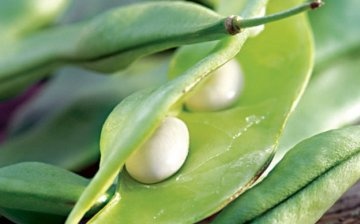Growing beans: important points for a good harvest
Common beans are represented by a huge variety of types, have distinctive morphological features, of which the inflorescence and flower are the most stable. Beans are a short-day plant, spring and herbaceous, grown only for a year. The soil for growing beans must be fertile, therefore it is recommended to add mineral and organic substances to the soil during pre-sowing preparation. Beans are sown later than other crops. When sowing, the soil is cultivated at the same time, usually at the very end of the sowing work. Presowing soil preparation aims to preserve the maximum amount of moisture and loosen the upper soil layer.
Content:
- Growing beans: important points
- Shoots. When to expect them and what next?
- Bean ripening and bean storage
Growing beans: important points
The plant is planted about 3-5 centimeters in depth, this is necessary so that the beans can easily bring the cotyledons to the surface. The seeds of the plant are presented in various forms, such as spherical-elliptical, elongated-roll, flat-reniform, with a smooth surface, in addition, they have different colors and may even have a pattern on the surface. For growing beans, the most optimal temperature is 18-20 ° C, but the initial temperature should be lower - 8-10 ° C. In the case of swelling in the first 50 hours, up to 120% of moisture is absorbed per absolutely dry substance.
Shoots. When to expect them and what next?
Germination of seeds requires a sufficient amount of oxygen, heat, moisture, all this is given to the seeds with a suitable looseness of the soil and the required sowing depth, of course, subject to proper preparation. It is extremely important that the sprouts are at the optimum temperature, because at 0 ° C they can be damaged, and at -1 ° C they can even die. Beans sprout in about 10 days. By the structure of the stem beans can be divided into two types - the bush form (the stem does not grow for long, the bite grows due to lateral shoots, the height of the pagon is up to 50-70 cm), as well as the semi-peeling form (branches strongly at the bottom of the trunk, has an elongated internode, curly stem over 70 -80 cm.). First, on the lateral or main shoot, at the bottom of the stem, the petals of the first flower of the inflorescence open, which then spread to the top of the stem. The duration of the seedling-flowering period is 30 days or more.
The fruit of a bean is a bean consisting of seeds up to 30 mm long and two valves.
Beans can be of different shapes, for example, cylindrical, flat, curved, straight, etc. According to their structure, beans are divided into sugar, semi-sugar and shelling beans. Hulling - beans with a rather coarse parchment layer in the valves, the parchment layer in the semi-sugar ones in the valves is underdeveloped, and in the sugar ones it is not at all. Unripe beans are green in color, various shades - yellow, purple, variegated.
Bean ripening and bean storage
During ripening, the color of the beans changes from yellow to darker yellow, from green to straw yellow, brown, dark green. The ripe fruit looks dry, its lower leaves turn yellow and die off, while the upper ones still remain green. Flowering, during which the seeds begin to ripen, lasts about 50 days. Maturation beans happens unevenly.
Harvesting beans is done in several ways.If suddenly the end of August is overtaken by damp, cold weather, then part of the stem with unripe beans of climbing varieties should be placed in a ventilated barn in which the beans will gradually ripen, this must be done with other bush crops. There are several ways to grow beans at home. If you grow it as a main crop, you will need a separate planting bed. In addition, it is possible to grow beans as a compacting crop by sowing the plant with other vegetables.
When growing beans in a detached bed, it is recommended to choose bush beans due to the ease of caring for the plant.
When growing curly beans as the main crop, it is worth remembering that the garden bed should include no more than two rows, otherwise it will interfere with the setting of a support, and the other part of the plants will be in the shadow of neighbors. It is recommended to grow climbing varieties between cucumbers and zucchini, in addition, it is a good idea to place seeds along the edges of the garden. The selected bed is marked with a circle with a diameter of about 20-40 cm, and 8-12 seeds are sown in a circle. A stake is driven into the center of the circle, to a depth of 40 cm, which must withstand a large weight. It is advisable to set the stake even before germination, although this may prevent the seedlings from being sheltered from frost. In order for the leaves to curl around the stake, they need to be set in the correct direction at the time when they begin to curl. A column of leaves quickly appears around the stake. Initially, pink or white brushes break through from under the leaves, after which the fruits appear. This method looks beautiful, requires little space, and is very productive. And this is how beans are grown on a trellis:








As far as I remember, my grandmother always planted beans at the same time as potatoes. To put it more precisely, she threw 2-3 beans into the hole with potatoes. As a result, we had plenty of beans all the time.
Yes, beans are planted at the same time as potatoes, but I was interested in your planting method: beans and potatoes in one hole. And how will you process the potatoes and then dig them out. Beans take a little longer to ripen than potatoes.